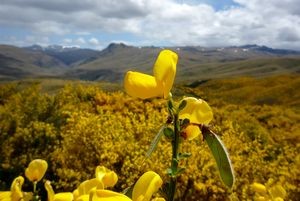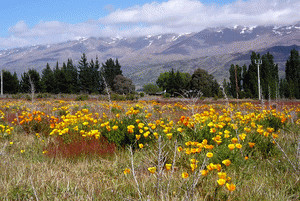 Broom (Cytisus scoparius) invading tall tussock grassland, western Otago. Photo: Jesse Bythell
Broom (Cytisus scoparius) invading tall tussock grassland, western Otago. Photo: Jesse Bythell Exotic plants now dominate the landscape in many parts of New Zealand. Photo: Jesse BythellOver 30,000 introduced plant species occur in New Zealand, arriving here either deliberately or accidentally, and many have adapted well to the New Zealand environment. Of these more than 2,500 have become naturalised in the New Zealand environment, meaning they have established and are reproducing in the wild. Of these naturalised species, more than 300 plants have become environmental weeds meaning they impact detrimentally on the structure, functions or composition of New Zealand’s indigenous plant communities, waterways and fauna.
Exotic plants now dominate the landscape in many parts of New Zealand. Photo: Jesse BythellOver 30,000 introduced plant species occur in New Zealand, arriving here either deliberately or accidentally, and many have adapted well to the New Zealand environment. Of these more than 2,500 have become naturalised in the New Zealand environment, meaning they have established and are reproducing in the wild. Of these naturalised species, more than 300 plants have become environmental weeds meaning they impact detrimentally on the structure, functions or composition of New Zealand’s indigenous plant communities, waterways and fauna.
Information is provided here about all New Zealand’s naturalised exotic plant species (including those that have become environmental weeds). Observations of occurrences of naturalised plants may also be recorded:
- Search for an exotic plant
- Unwanted Organisms
- DOC Weeds
- Plant me Instead
- National Pest Plant Accord (NPPA)
- Weed control
For more information go to:
- Weedbusters (the national weeds awareness and education programme)
- Exotic plants (Wikipedia)
